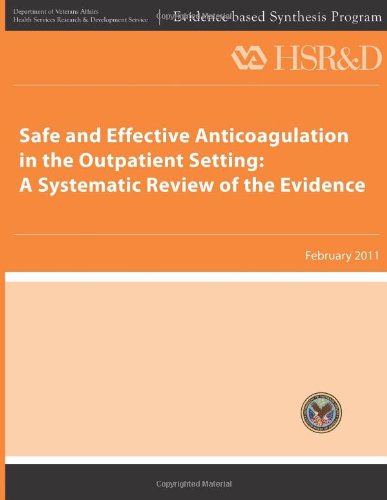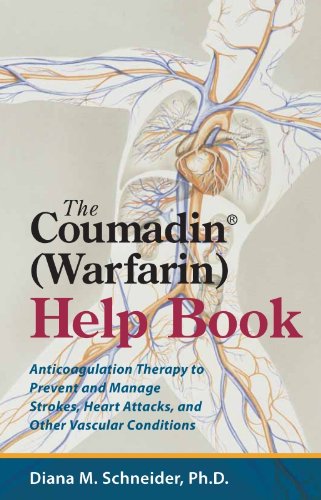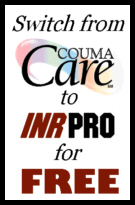Anticoagulant Books and Therapy Guidelines >>>
Here are some books and literature on anticoagulation practices and guidelines that you might helpful in making your clinic or practice more successful.
This book covers a wide range of disorders such as atrial fibrillation, artificial heart valves, deep vein thrombosis, pulmonary embolism and stroke. Handbook of Oral Anticoagulation aims to provide an accessible overview of the exciting new developments in this field. Incorporating numerous quick-reference tables and figures and fully referenced throughout to key papers and the latest reviews, it will be a useful resource for all healthcare professionals involved in thromboprophylaxis.
Read more
As a leader in safety and quality, the Department of Veterans Affairs (VA) is interested in assuring that veterans on long-term anticoagulation receive state-of-the-art care that maximizes efficacy and minimizes complications. Towards that end, this review was commissioned by the VA�s Evidence-based Synthesis Program, in conjunction with the Office of Quality and Performance.
The final key questions are: Anticoagulants can be dangerous drugs. Developed to save lives by preventing and treating thrombosis, these widely used medications are linked to unacceptable levels of morbidity and mortality. According to a study by the Institute for Safe Medication Practices, 8.2% of hospitalized patients on warfarin and 13.6% exposed to heparin experience an adverse drug event. To prevent these events from occurring, clinicians monitor anticoagulation therapy closely. But there are still questions. What is the risk of stroke in a patient who has specified CHADS2 risk factors? What is the recommended perioperative treatment? Find life-saving solutions quickly to these challenges and more with Anticoagulation Therapy: A Point-of-Care Guide, edited by William Dager, Michael Gulseth, and Edith Nutescu.
This concise reference is designed with the busy clinician and resident in mind. It provides a quick way to access necessary clinical and therapeutic information that has the potential to improve the lives when many risk factors are at play and time is of the essence.
Inside you'll find:
The second book in the Point-of-Care series, Anticoagulation Therapy is led by a team of editors with more than 77 combined years of clinical experience, including insight from 19 contributors. The book is divided into three sections, including: Anticoagulation Medication Management, Conditions Requiring Anticoagulation Therapy, and Practical Monitoring and Coagulation Laboratory Insights.
Read more
This essential guide was written for everyone who must take the anticoagulation drugs Coumadin or its generic form warfarin, and who finds the dietary and medication guidelines that need to be followed both confusing and complicated. It explains why these drugs require modifications to the diet and careful monitoring of both prescription and over-the-counter medications, emphasizing that consistency is the key to success. It will help readers to live a normal, healthy life despite the restriction involved in successfully taking this medication; tables containing information about foods and drugs will be referred to constantly. This book provides the information that every person who requires anticoagulation therapy needs to manage their medication and get on with their lives.
Coumadin and warfarin are the most commonly prescribed anticoagulants � or "blood thinner" used to prevent strokes and heart attacks resulting from blood clots in people with a variety of medical conditions. This includes the more than 10% of people over age 65 who have atrial fibrillation, anyone who a prosthetic heart valve or other cardiac conditions that can lead to the formation of blood clots, following any episode of deep vein thromboembolism, and people who have already suffered a stroke or heart attack.
The book provides detailed information on:
Provides the resources and information to enhance the care of patients receiving oral anticoagulation therapy. Written by a diverse and multidisciplinary group of health care professionals with hands-on experience, this book focuses on the anticoagulation management service�a model of anticoagulation care that is systematic, organized, and coordinated. All aspects of development and implementation of this care model are addressed.
The book is divided into two sections: Part 1, Establishing an Anticoagulation Management Service, and Part 2, The Use of Oral Anticoagulants.
Features and Benefits:
Anticoagulation medications are a high-risk treatment that commonly leads to adverse drug events due to the complexity of dosing these medications, monitoring their effects, and ensuring patient compliance. This new resource is designed to help performance improvement directors, pharmacists, directors of nursing, and medical staff assess the safety of their current anticoagulation practices and/or implement a defined anticoagulation management program. The implementation guide includes an accompanying CD-ROM with practical forms, examples, and other tools that any size organization can consider for its program.
Read more
 Handbook of Oral Anticoagulation (Dec 2013)
Handbook of Oral Anticoagulation (Dec 2013)
 Safe and Effective Anticoagulation in the Outpatient Setting: A Systematic Review of the Evidence (May 2013)
Safe and Effective Anticoagulation in the Outpatient Setting: A Systematic Review of the Evidence (May 2013)
Read more
 Anticoagulation Therapy: A Point-of-Care Guide (Mar. 2011)
Anticoagulation Therapy: A Point-of-Care Guide (Mar. 2011)
Read more
Read more
 Anticoagulation Therapy: Toolkit for Implementing the National Patient Safety Goal (Sep 2008)
Anticoagulation Therapy: Toolkit for Implementing the National Patient Safety Goal (Sep 2008)

Helping manage anticoagulation patients for over 20 years





INR Pro highlighted in latest issue of Group Practice Journal!
Latest Articles
INR Pro featured in medical group magazine
Rosendaal method for patient TTR calculations available in Excel template
New INR data reports available from your current anticoagulation system

Monitored by Site24x7
Uptime